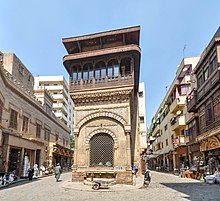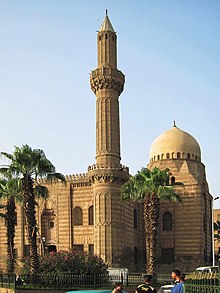Ottoman architecture in Egypt

Ottoman architecture in Egypt, during the period after the
Background: Ottoman provincial architecture
In the provinces of the empire that were more distant from the imperial capital, the encounter between Ottoman influence and local traditions had a variety of outcomes.[1] In the Middle East and North Africa, where Arabic and Islamic culture was long-established, Ottoman governors and other officials sent from the capital often respected or adapted to local culture, while existing Islamic architectural styles remained dominant or were blended with elements of Ottoman architecture. In Egypt and the Levant, Mamluk architecture had been the prevailing architectural tradition and it remained in fashion even after the Mamluk Empire was defeated by the Ottomans.[6]
Architecture in the 16th-18th centuries
General
In 1517 the Ottoman conquest of Egypt formally brought Mamluk rule to an end, although Mamluks themselves continued to play a prominent role in local politics.[7] In architecture, there was significant continuity with existing Mamluk architectural style, but new Ottoman features and building types were introduced.[1] For example, most Egyptian mosques of the period consistently adopt the pointed Ottoman style of minaret rather than the more ornate traditional Mamluk-style minaret, which is one of the features that visually denoted Ottoman hegemony in the urban landscape.[8][9] In the late Mamluk period stone domes had become almost exclusively associated with mausoleums, but under Ottoman influence they were used to roof the prayer halls of mosques.[1] The scale of architectural patronage also declined in comparison with previous periods.[1]
The sabil-kuttab (
Tile decoration, which was not characteristic of earlier Mamluk architecture, was a recurrent addition to new and old buildings during the Ottoman period. In addition to
16th and 17th centuries

The
In Cairo, the closest representative of
As the construction of new monumental funerary complexes declined in Cairo during the Ottoman period, local Ottomans were instead buried in older mausoleums from earlier periods.[24] A well known example is the 14th-century Aqsunqur Mosque (now also known as the "Blue Mosque"), which was renovated in 1652 by Ibrahim Agha, a local Janissary commander. The renovation added extensive Ottoman Iznik tile decoration on the qibla wall and in the attached tomb he built for himself.[25][26] Another example of a Mamluk building repurposed is the 14th-century Madrasa of Amir Sunqur Sa'di, which an Ottoman pasha gifted in 1607 to the Mevlevis, a Sufi order popular in the Ottoman Empire.[27] A Sufi ceremonial hall, still extant today, was later built over the remains of the madrasa's courtyard in the 19th century.[28]
18th century

In the 18th century the power of the local Janissaries and allied urban notables increased.[10] Buildings sponsored by local elites were generally still built in an Ottoman-Mamluk hybrid style, such as the Sabil-kuttab of Abd ar-Rahman Katkhuda (mentioned above). While Mamluk-era configurations remained predominant, Ottoman decoration was applied in highly visible ways in some local monuments, most notably in the use of Ottoman blue and white tiles, including re-used 16th-century Iznik tiles imported from Istanbul.[10]
Abd al-Rahman Katkhuda, a Mamluk who occupied multiple high offices over several decades, was the greatest patron of architecture in the 18th century, sponsoring the construction or restoration of 33 monuments around Cairo.[29][30] In addition to his aforementioned sabil-kuttab on al-Mu'izz street and other projects, he sponsored a major expansion of al-Azhar Mosque which was completed circa 1753. Among the structures he added to the mosque's is its present-day western gate, the Gate of the Barbers (Bab al-Muzayyinin). His constructions are marked by ornate stonework that attest to a revival of the decorative style of Sultan Qaytbay's reign in the late 15th century.[31]

One of the notable mosques from this period is the
Although local patrons dominated, a few rare monuments sponsored by Ottoman sultans were also built in Cairo in the mid-18th century, demonstrating a certain level of renewed imperial interest in the city.
Outside Cairo, the town of Rashid (Rosetta) is known today for its houses and mosques preserved from the Ottoman period.[35] The town was an important center of maritime trade in Ottoman Egypt from the 16th to 18th centuries.[36] At least two important mosques in the city date from the 18th century: the Mosque of Salah Agha Duqmaqsis (1702) and the Mosque of Muhammad al-'Abbasi (1773, but probably restored in 1809).[37] The Mosque of Duqmaqsis is notable as the only "raised" mosque in the city, built above a substructure of vaulted storerooms and shops. Among its decoration is a variety of tiles, including contemporary Tunisian tiles, reused 16th-century Iznik tiles, and Damascus-produced imitations of Iznik tiles.[38]
Architecture in the 19th century
In the 19th century, under the

The new style of this period also appears in multiple sabil-kuttabs built throughout the city, which feature curved street facades carved with new leaf, garland, and sunburst motifs.[47][41] Examples include the Sabil of Tusun Pasha (1820; also known as the Sabil of Muhammad Ali Pasha[48]), the Sabil of Isma'il Pasha (1828), and Sabil of Umm Abbas.[47] The larger Sabil and Mosque complex of Sulayman Agha al-Silahdar (1839) is also an example.[47][49] In the Cairo Citadel, Muhammad Ali also constructed several new palaces, some of which survive today and have been repurposed as museums, including the Gawhara Palace (1814) and the Harim Palace (1827; now the Egyptian National Military Museum). These palaces are a mix of Ottoman Baroque and European styles, decorated with gilding, molded motifs, painted ceilings, and frescoes.[50]
See also
Notes
- ^ a b c d e f g Blair & Bloom 1995, p. 251.
- ISBN 9780195309911.
- ^ a b Blair & Bloom 1995, p. 218.
- ^ a b Blair & Bloom 1995, p. 219-220.
- ^ a b Blair & Bloom 1995, p. 252.
- ^ a b Kuban 2010, p. 584-585.
- ^ Raymond, André. 1993. Le Caire. Fayard.
- ^ a b Kuban 2010, p. 585.
- ^ Williams 2018, p. 34.
- ^ .
- ^ Williams 2018, p. 230.
- ^ Karim & El Mahy 2021, pp. 25, 188–189.
- ISBN 9789774160776.
- ^ Behrens-Abouseif 1989, p. 160.
- ^ O'Kane 2016, p. 255.
- ^ Behrens-Abouseif 1989, pp. 163–164.
- ^ a b Goodwin 1971, p. 312.
- ^ Williams 2018, p. 269-270.
- ^ Behrens-Abouseif 1989, p. 269.
- ^ a b Behrens-Abouseif 1989, p. 161.
- ^ a b Williams 2018, p. 302.
- ^ Kuban 2010, p. 584.
- ^ Williams 2018, p. 302-303.
- ^ Williams 2018, p. 103.
- ^ Carswell 2006, p. 107.
- ^ Behrens-Abouseif 1989, p. 116.
- ^ Fanfoni, Giuseppe (1999). "The foundation and organization of the Cairo Mawlawiyya". Quaderni di Studi Arabi. 17: 105–122.
- ^ Williams 2018, p. 135.
- ^ Williams 2018, pp. 130, 230.
- ^ Karim & El Mahy 2021, p. 133.
- ^ Karim & El Mahy 2021, pp. 135, 149–150.
- ^ Behrens-Abouseif 1989, pp. 165–166.
- ^ Rüstem 2019, p. 288 (note 18).
- ^ Rüstem 2019, p. 180-181.
- ISBN 9780195309911.
- ISBN 978-90-04-09834-3.
- ^ O'Kane 2016, pp. 275, 291.
- ^ O'Kane 2016, pp. 275–276.
- ^ JSTOR 1523134.
- ISBN 9789774160950.
- ^ a b Behrens-Abouseif 1989, pp. 167–170.
- ^ Williams 2018, p. 264.
- ^ Goodwin 1971, p. 408.
- ^ Behrens-Abouseif 1989, p. 168-169.
- ^ Williams 2018, p. 262-266.
- ISBN 9789774160950.
- ^ a b c Williams 2018, pp. 137, 194, 226, 240, 264–265.
- ^ "Sabil of Muhammad Ali in al-'Aqadin". egymonuments.gov.eg. Retrieved 2023-01-17.
- ^ Behrens-Abouseif 1989, p. 167.
- ^ Williams 2018, pp. 263–264, 268–269.
References
- Bates, Ülkü Ü. (1985). "Two Ottoman Documents on Architects in Egypt" (PDF). Muqarnas. 3: 121–127. JSTOR 1523088.
- Behrens-Abouseif, Doris (1989). Islamic Architecture in Cairo: An Introduction (PDF). Leiden, the Netherlands: E.J. Brill. ISBN 9789004096264.
- Blair, Sheila S.; Bloom, Jonathan M. (1995). The Art and Architecture of Islam 1250-1800. Yale University Press. ISBN 9780300064650.
- Carswell, John (2006). Iznik Pottery (Second ed.). British Museum Press. ISBN 9780714124414.
- Goodwin, Godfrey (1971). A History of Ottoman Architecture. Thames & Hudson. ISBN 0-500-27429-0.
- Hanna, Nelly (1983). An Urban History of Būlāq in the Mamluk and Ottoman Periods. Cairo: Institut francais d'archeologie orientale. (review: Goodwin, Godfrey (15 March 2011). "An Urban History of Būlāq in the Mamluk and Ottoman Periods. By Nelly Hanna. (Supplément aux Annales Islamologiques, Cahier No. 3.) pp. ix, 112, 10 pls. [Le Caire], Institut Français d'Archéologie Orientale, 1983". Journal of the Royal Asiatic Society of Great Britain & Ireland. 117 (2): 201. S2CID 163066491.
- Karim, Chahinda; El Mahy, Menna M. (2021). Ottoman Cairo: Religious Architecture from Sultan Selim to Napoleon. American University in Cairo Press. ISBN 978-1-64903-084-9.
- Kuban, Doğan (2010). Ottoman Architecture. Translated by Mill, Adair. Antique Collectors' Club. ISBN 9781851496044.
- O'Kane, Bernard (2016). The Mosques of Egypt. American University of Cairo Press. ISBN 9789774167324.
- Raymond, André (1998). Le Caire des Janissaires : l'apogée de la ville ottomane sous ʻAbd al-Rahmân Katkhudâ (in French). CNRS éditions. S2CID 163051032.)
- Watenpaugh, Heghnar Zeitlian (1 January 2007). "An Uneasy Historiography: The Legacy of Ottoman Architecture in the Former Arab Provinces" (PDF). Muqarnas Online. 24: 27–43. .
- Williams, Caroline (2018). Islamic Monuments in Cairo: The Practical Guide (7th ed.). Cairo: The American University in Cairo Press.


